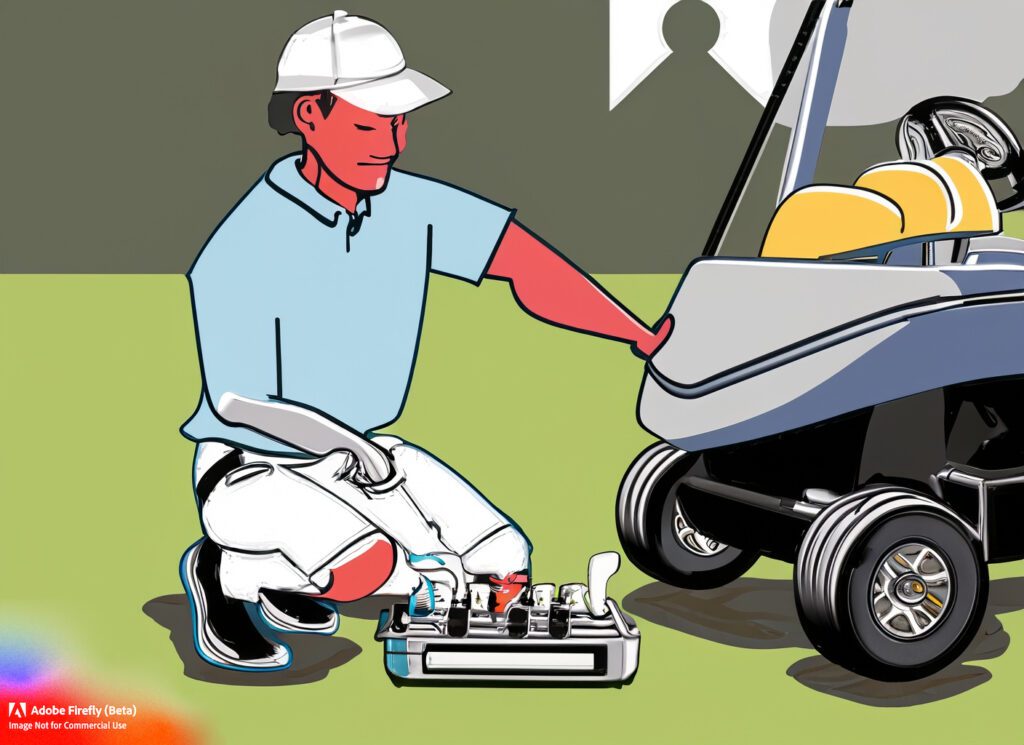Golf cart batteries are a type of lead-acid battery that is designed to provide power to electric golf carts. They are typically deep-cycle batteries, which means they are designed to be discharged and recharged repeatedly without damaging the battery. They are usually 6, 8, or 12 volts and are connected in series to produce the total voltage required by the golf cart. The capacity of golf cart batteries is measured in amp hours, which indicates how much current the battery can provide over a certain period of time.
How Long Do Golf Cart Batteries Last?
Overcharging or undercharging are the two most common ways a golf cart battery’s life can be shortened. Overcharging can cause the water in the battery to evaporate, damaging the internal structure. Undercharging, on the other hand, can lead to sulfation, where sulfuric acid crystallizes on the lead plates, reducing the battery’s ability to hold a charge.
To maximize the life of your golf cart battery, follow these tips:
- Regular Cleaning: Clean the battery terminals regularly to remove corrosion. This can be done with a mixture of baking soda and water.
- Proper Charging: Do not overcharge or undercharge the battery. Use a good-quality charger that automatically turns off when the battery is fully charged. Do not let the battery discharge completely before charging it again.
- Regular Inspection: Check the battery regularly for signs of damage, such as cracks or leaks. Replace damaged batteries immediately.
- Water Levels: Check the water levels in the battery regularly. If the water level is low, fill it up with distilled water. Do not overfill as it can lead to acid spills.
- Proper Storage: If you’re not using the golf cart for a long time, store the battery in a cool and dry place. Disconnect it from the golf cart to prevent any power drain.
- Regular Use: Regular use helps to maintain the battery’s health. Even if you’re not using the golf cart regularly, take it out for a drive once in a while to keep the battery active.
Remember, taking good care of your golf cart battery will not only extend its life but also improve the performance of your golf cart.
Understanding Golf Cart Batteries
When it comes to golf cart batteries, it’s crucial to understand the different types available and their benefits and drawbacks. Proper battery selection plays a significant role in ensuring optimal performance and longevity.
Types of Golf Cart Batteries

- Lead-Acid Batteries: Lead-acid batteries have been the traditional choice for golf carts. They are affordable and widely available. These batteries rely on a chemical reaction between lead plates and sulfuric acid to produce electrical energy. However, they require regular maintenance, including checking fluid levels and periodic recharging.
- Lithium-Ion Batteries: Lithium-ion batteries have gained popularity due to their durability and improved performance. They offer a longer lifespan compared to lead-acid batteries and require minimal maintenance. While they may have a higher upfront cost, they provide benefits such as faster charging times, lighter weight, and increased energy efficiency.
| Lithium-Ion Batteries | Lead-Acid Batteries | |
|---|---|---|
| Pros | High energy density | Lower cost |
| Lightweight | Well-established technology | |
| Longer cycle life | Robustness | |
| Faster charging | Wide temperature range | |
| No maintenance required | ||
| Cons | Costly | Heavy and bulky |
| Safety concerns | Limited cycle life | |
| Environmental concerns | Maintenance requirements | |
| Lower efficiency |
Factors Affecting the Lifespan of Golf Cart Batteries
Several factors can influence the lifespan of golf cart batteries. By understanding these factors, you can implement proper maintenance practices and maximize the longevity of your batteries.
Proper Maintenance Practices
To ensure the longevity of your golf cart batteries, it is essential to follow recommended maintenance practices:
- Checking and Maintaining Fluid Levels: Regularly inspect the electrolyte levels in lead-acid batteries and top them up with distilled water as needed. This helps prevent the plates from being exposed and extends the battery’s lifespan[^Continental Battery Blog.
- Using the Correct Charger and Following Manufacturer Guidelines: Each type of battery has specific charging requirements. It is crucial to use a charger that is compatible with your golf cart battery and follow the manufacturer’s guidelines for optimal charging. This helps prevent overcharging or undercharging, which can negatively impact battery performance and lifespan.
- Trickle Charging During Storage Periods: If you plan to store your golf cart for an extended period, consider using a trickle charger. Trickle charging provides a low, continuous charge to the battery, preventing it from discharging completely and maintaining its overall health[^Golf Cart Garage Blog^].
- Reducing Corrosion: Regularly clean the battery terminals and connections to prevent the buildup of corrosion. Corrosion can impede the flow of electricity and impact battery performance. Applying a thin layer of petroleum jelly or battery terminal protectant can help minimize corrosion[^Golf Circuit^].
Usage and Driving Distance
The lifespan of golf cart batteries can also be influenced by how often and how far you use your cart. Factors to consider include:
- Frequency of Use: Frequent use of your golf cart puts more strain on the batteries, which can shorten their lifespan. If you use your cart daily, it may require more frequent battery replacements compared to carts used less frequently.
- Driving Distance: The distance you typically drive your golf cart also affects battery life. Longer drives and continuous usage can lead to more discharge cycles, which can gradually reduce the battery’s capacity over time.
Additional Options and Accessories on the Cart
The presence of additional options and accessories on your golf cart can impact the performance and lifespan of the batteries. Extra accessories such as lights, stereos, and fans draw power from the batteries, which can increase the rate of discharge. It is essential to consider the power demands of these accessories and ensure your batteries can handle the additional load.
By taking these factors into account and implementing proper maintenance practices, you can extend the lifespan of your golf cart batteries and maximize their performance on the course.
Signs that Your Golf Cart Battery Needs to be Replaced
Even with proper maintenance, golf cart batteries will eventually reach the end of their lifespan. It’s important to be aware of the signs that indicate a battery needs to be replaced. By recognizing these signs early on, you can avoid unexpected breakdowns and ensure the continued performance of your golf cart.
1. Longer Charging Times
If you notice that your golf cart battery takes significantly longer to charge than usual, it may be a sign that the battery is deteriorating. As batteries age, their internal resistance increases, causing them to take longer to reach a full charge.
2. Decreased Power and Performance
A noticeable decrease in power and performance is another indicator that your golf cart battery might be nearing the end of its lifespan. You may experience reduced acceleration, slower top speeds, and decreased driving range. If your once zippy cart feels sluggish and lacks power, it’s time to consider replacing the battery.
3. Visible Damage or Swelling
Inspect your golf cart battery regularly for any visible signs of damage or swelling. This includes bulging or deformed battery cases and leaking electrolytes. These issues can indicate internal damage or a compromised seal, both of which can affect the battery’s performance and safety. If you notice any of these signs, it’s crucial to replace the battery promptly].
4. Age of the Battery
The age of your golf cart battery is an essential factor to consider when assessing its lifespan. Lead-acid batteries typically last between 4 to 6 years with proper maintenance, while lithium-ion batteries can last up to 20 years. To determine the age of a lead-acid battery, check the two digits on the negative post.
5. Reduced Run Time
If you find that your golf cart’s run time has significantly decreased, it could be a sign that the battery capacity has diminished. As batteries age, their ability to hold a charge diminishes, resulting in reduced run time on a single charge. If you’re finding yourself needing to recharge more frequently or the battery drains quickly, it may be time to consider a replacement.
Remember to consult the manufacturer’s guidelines and recommendations for your specific battery type and model. Properly maintaining and promptly replacing your golf cart battery when necessary will ensure optimal performance and longevity for your cart.
Tips for Extending the Lifespan of Golf Cart Batteries
Proper maintenance and care can significantly extend the lifespan of your golf cart batteries. By following these tips, you can ensure optimal performance and longevity for your batteries.
1. Maintain Fluid Levels
Regularly check and maintain the fluid levels in your golf cart batteries. Lead-acid batteries require proper electrolyte levels to function optimally. Be sure to use distilled water to top up the electrolyte levels, as tap water may contain impurities that can affect battery performance.
2. Use the Correct Charger
Using the correct charger is crucial for the health of your golf cart batteries. Different types of batteries require specific charging parameters. Ensure that you are using a charger that is compatible with your battery type and follow the manufacturer’s guidelines for charging. This will prevent overcharging or undercharging, which can negatively impact battery lifespan.
3. Trickle Charging during Storage
If you plan to store your golf cart for an extended period, consider using a trickle charger. Trickle charging provides a low, continuous charge that helps maintain the battery’s state of charge without overcharging it. This is especially beneficial during periods of non-use, such as winter storage.
4. Prevent Corrosion
Corrosion can hinder the performance of your golf cart batteries. Regularly clean the battery terminals and connections to remove any buildup of corrosion. Applying a thin layer of petroleum jelly or using a battery terminal protectant can help prevent corrosion and ensure proper electrical conductivity.
5. Follow Manufacturer Guidelines

Each battery manufacturer may have specific guidelines for maintenance and care. It’s important to familiarize yourself with these guidelines and follow them accordingly. This includes recommendations for charging, maintenance schedules, and any specific considerations for your battery type.
By implementing these tips and adhering to proper maintenance practices, you can maximize the lifespan of your golf cart batteries and enjoy extended performance on the course.
The Benefits and Drawbacks of Different Types of Golf Cart Batteries
When it comes to golf cart batteries, there are different types available, each with its own set of benefits and drawbacks. Understanding these differences can help you make an informed decision when choosing the right battery for your golf cart.
Lead-Acid Batteries
Lead-acid batteries are the most common type of battery used in golf carts. They are affordable and have been around for many years. Here are some key points to consider:
- Benefits: Lead-acid batteries are widely available and come in various sizes and capacities to suit different golf cart models. They can provide sufficient power for most golf cart applications and are generally cheaper to replace compared to other battery types. Additionally, they have a proven track record of performance in the golf cart industry[^Battle Born Batteries^].
- Drawbacks: One drawback of lead-acid batteries is that they require regular maintenance. This includes checking and maintaining the fluid levels, cleaning the terminals, and ensuring proper charging. They are also heavier than other battery types, which can affect the overall weight and performance of the golf cart[^Continental Battery Blog^].
Lithium-Ion Batteries
Lithium-ion batteries are a relatively newer option for golf cart owners. While they come with a higher price tag, they offer some distinct advantages:
- Benefits: Lithium-ion batteries are known for their high energy density, which means they can provide more power in a smaller and lighter package. They have a longer lifespan compared to lead-acid batteries, with some models lasting up to 20 years[^Battle Born Batteries^]. Lithium-ion batteries also require less maintenance, as they do not need regular fluid level checks or terminal cleaning[^Battle Born Batteries^].
- Drawbacks: The main drawback of lithium-ion batteries is their initial cost. They are typically more expensive than lead-acid batteries, which can be a significant investment upfront. However, it’s important to consider the long-term savings in terms of extended lifespan and reduced maintenance requirements[^Battle Born Batteries^].
It’s worth noting that the choice between lead-acid and lithium-ion batteries depends on factors such as budget, usage requirements, and personal preferences. Assessing the pros and cons of each type will help you determine which battery is the best fit for your specific needs.
Remember to consult with your golf cart manufacturer and battery supplier for further guidance and recommendations based on your golf cart’s specifications and usage patterns.
Signs that Indicate Your Golf Cart Battery Needs Replacement
Over time, golf cart batteries will inevitably wear out and need to be replaced. Being aware of the signs that indicate a declining battery can help you address the issue proactively. Here are some common signs that it’s time to replace your golf cart battery:
1. Longer Charging Times
If you notice that your golf cart battery takes significantly longer to charge than it used to, it may be a sign of a deteriorating battery. As batteries age, their capacity decreases, leading to longer charging times[^Battle Born Batteries^]. If you find yourself spending more time waiting for your battery to charge, it’s a good indication that a replacement is needed.
2. Decreased Power and Performance
As a golf cart battery nears the end of its lifespan, you may notice a decline in power and overall performance. The cart may struggle to maintain its usual speed and may not have the same acceleration as before[^Battle Born Batteries^]. If you experience a noticeable decrease in power, it’s a clear indicator that it’s time to replace the battery.
3. Visible Damage or Leaking
Inspect your golf cart battery regularly for any visible signs of damage or leaking. Cracks, bulges, or corrosion on the battery casing are all indications of a problem[^Battle Born Batteries^]. Leaking battery acid is a serious issue and should be addressed immediately. If you notice any visible damage or leaking, it’s essential to replace the battery promptly to ensure safe and reliable operation.
4. Age of the Battery
The age of your golf cart battery is also a significant factor in determining its lifespan. Lead-acid batteries typically last between 4-6 years with proper maintenance, while lithium-ion batteries can last up to 20 years[^Isle Golf Cars^][^Battle Born Batteries^]. If your battery is nearing or exceeding its expected lifespan, it’s wise to start considering a replacement, even if you haven’t experienced any noticeable issues yet.
By paying attention to these signs, you can stay ahead of potential battery problems and prevent unexpected breakdowns on the course. It’s always better to replace a battery before it completely fails to ensure uninterrupted enjoyment of your golf cart.
Sources:
– Battle Born Batteries
– Isle Golf Cars
Tips for Maintaining and Extending the Lifespan of Your Golf Cart Battery

Proper maintenance and care can significantly extend the lifespan of your golf cart battery. By following these tips, you can maximize the performance and longevity of your battery, saving you time and money in the long run.
1. Maintain Fluid Levels
Regularly check the fluid levels in your lead-acid golf cart battery. Ensure that the electrolyte solution covers the battery plates adequately. If the fluid level is low, add distilled water to bring it up to the recommended level. Be cautious not to overfill, as it can lead to electrolyte overflow during charging.
2. Use the Correct Charger
Using the correct charger for your golf cart battery is crucial for its health and longevity. Consult the manufacturer’s guidelines or your golf cart dealer to ensure you have the right charger for your specific battery type and model. Using a charger with incorrect voltage or charging capacity can damage the battery and shorten its lifespan.
3. Trickle Charge During Storage
If you plan to store your golf cart for an extended period, it’s advisable to use a trickle charger to maintain the battery’s charge. A trickle charger provides a low, constant charge, preventing deep discharge and sulfation, which can damage the battery[^Golf Cart Garage^]. Follow the manufacturer’s recommendations for the appropriate trickle-chargingHow Long Do Trojan Golf Cart Batteries Last? procedure.
4. Reduce Corrosion
Corrosion can negatively impact the performance and lifespan of your golf cart battery. To minimize corrosion, regularly clean the battery terminals and cables using a mixture of baking soda and water[^Golf Cart Garage^]. Gently scrub the terminals and cables with a brush, then rinse with clean water and dry thoroughly. Applying a thin layer of petroleum jelly or terminal protector spray can also help prevent future corrosion[^Golf Cart Garage^].
5. Invest in a Quality Battery
Choosing a high-quality battery from a reputable manufacturer can make a significant difference in the lifespan and performance of your golf cart battery. Research different brands and read customer reviews to find a battery known for its durability and reliability[^Golf Circuit^]. A quality battery may have a slightly higher upfront cost but can provide better long-term value and performance.
Remember, regular maintenance and proper care are key to extending the lifespan of your golf cart battery. By implementing these tips, you can optimize the performance and ensure many years of enjoyable golf cart rides.
Source:
– Golf Cart Garage
– Golf Circuit
Conclusion- What Is The Average Lifespan of a Golf Cart Battery?
In conclusion, understanding the average lifespan of a golf cart battery is essential for every golf cart owner. While the exact lifespan can vary depending on factors like maintenance, usage, and battery type, being aware of the signs that indicate a declining battery is crucial. If you notice longer charging times, decreased power and performance, visible damage or leaking, or if your battery is nearing its expected lifespan, it’s time to consider a replacement.
To maintain and extend the lifespan of your golf cart battery, follow these essential tips:
- Maintain Fluid Levels: Regularly check and maintain the proper fluid levels in your lead-acid battery.
- Use the Correct Charger: Ensure you have the right charger for your specific battery type and model.
- Trickle Charge During Storage: Use a trickle charger to keep your battery charged during periods of non-use.
- Reduce Corrosion: Clean the battery terminals and cables regularly to prevent corrosion.
- Invest in a Quality Battery: Choose a high-quality battery from a reputable manufacturer.
By implementing these maintenance tips, you can optimize the performance of your golf cart battery and enjoy many years of reliable use. Remember, proper care and attention to your battery can save you time and money in the long run.
We hope you found this article helpful and informative. For more great content on golf carts and related topics, be sure to check out our other articles. Happy golfing!
Questions & Answers
Who determines the average lifespan of a golf cart battery?
The average lifespan of a golf cart battery is determined by various factors, including maintenance, usage, and battery type.
What are the different types of golf cart batteries and their lifespans?
Golf cart batteries can be lead-acid or lithium-ion. Lead-acid batteries typically last 2-5 years, while lithium-ion batteries can last up to 20 years.
How can I extend the lifespan of my golf cart battery?
To extend your golf cart battery’s lifespan, maintain proper fluid levels, use the correct charger, trickle charge during storage, reduce corrosion, and invest in a quality battery.
What are the signs that indicate my golf cart battery needs to be replaced?
Signs that indicate a golf cart battery needs replacement include longer charging times, decreased power and performance, visible damage, and nearing the battery’s expected lifespan.
How much does it cost to replace a golf cart battery?
The cost of replacing a golf cart battery varies depending on the type. Lead-acid batteries cost around $1000-$1600 to replace, while lithium-ion batteries have a higher price point.
What are the advantages of using lithium-ion golf cart batteries?
Lithium-ion batteries offer advantages such as longer lifespan, lighter weight, faster charging, and higher energy efficiency compared to traditional lead-acid batteries.

I’m Donna Weiss, and I am the proud writer behind the captivating content you’ll find on golfneedy.com. As an avid golfer and passionate writer, I have combined my two greatest passions to bring you an incredible golfing experience. Through my articles, I aim to provide you with valuable insights, equipment reviews, and updates on the latest tournaments. Whether you’re a seasoned golfer or just starting out on this exciting journey, I am here to guide you and share my expertise. Together, let’s explore the fascinating world of golf, uncovering new techniques, and enhancing our skills. Join me on this thrilling adventure as we elevate our game and embark on an exciting golfing journey. Read More



